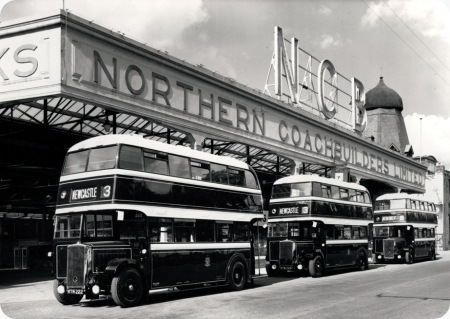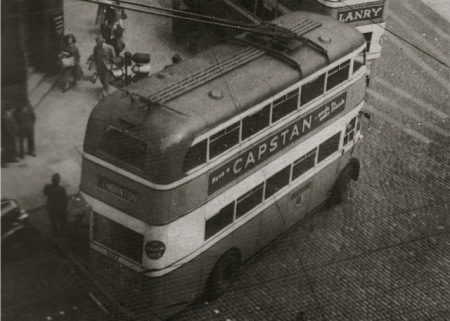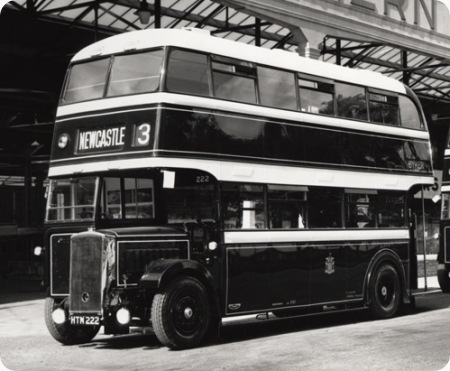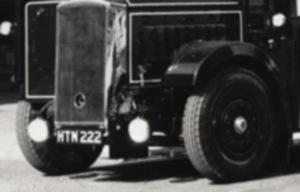Newcastle Corporation - Daimler COG5 - HTN 222 - ?

Photograph by ‘unknown’ if you took this photo please go to the copyright page.
Newcastle Corporation
1939
Daimler COG5
Northern Coachbuilders H56R
What looks like a pre delivery photo of three Daimlers for Newcastle Corporation, “note the blue light to the side of the destination blind” this has been commented on before on this site. Going by the registrations I would say they were built in the late 1930s, and to be honest if I were shown a picture of one of these in a different location I wouldn’t be able to say who the bodybuilder was, but I think the name on the building may be a clue.
What on earth were they thinking of with the front wing and the headlights? They look as if someone remembered them about ten minutes before they were due to leave the factory and they were stuck on as an afterthought, for me they completely spoil the look of what is otherwise a rather handsome vehicle. I don’t know anything about them, maybe someone can provide information for the ‘?s’. But if I’m right about the date they would almost certainly ‘or the chassis would’ have still been around until about the early to mid fifties.
Photograph and Copy contributed by Ronnie Hoye
06/06/12 - 07:50
Yes, good looking vehicles, spoiled by the apparent afterthought of where to place the headlamps. Then again, perhaps they did omit the headlamps entirely, as these are where most folk would expect the fog lights.
Pete Davies
06/06/12 - 07:51
HTN 231, 233, presumably from the same batch of 1939 NCB bodied COG5s,
finished up in 1956 with the LCBER bus fleet.
See my recent post, and fleet list on the
subject
John Whitaker
06/06/12 - 07:52
This picture appears in Alan Townsin’s book "Daimler", where it is credited to the Newcastle-upon-Tyne City Libraries. The photo was taken in June 1939, and shows the first three of a batch of 18 COG5 machines with Northern Coachbuilders bodies, which were followed by two more with Northern Counties bodies. This batch of 20 brought the total number of COG5 buses in the Newcastle fleet up to 71, the highest number outside Birmingham at that time.
Roger Cox
06/06/12 - 07:52
From the registration number this looks like the same series as the two mentioned in the recently posted fleet list of Llandudno & Colwyn Bay vehicles (Nos. 1 and 2).
Stephen Ford
06/06/12 - 11:38
Bus headlamps are a fascinating topic to study. Several operators in the late thirties decided that low mooted headlamps or maybe fog lamps were more effective for smog conditions in many of the major cities. The first LPTB RT AECs had no main headlamps in the traditional place, and similarly Coventry had some Daimler COG5s with only low mounted lights similar to the Newcastle COG5s.
Richard Fieldhouse
06/06/12 - 11:38
I gather from photos published elsewhere that it was not until January 1949 that legislation specified how the headlights had to be placed. Nottingham favoured low-down "driving lamps" like this from 1935 and only modified them when the law changed. Did it improve visibility in fog? We tend to forget that headlights were not used routinely on (reasonably) well-lit city roads until comparatively recently. I wonder how practical they were when fitted with blackout shutters during the war? I have also seen (possibly on this site - not sure) buses with the two headlights mounted at different heights.
Stephen Ford
06/06/12 - 17:34
I cannot remember where, Stephen, but you are right about asymmetrical
headlight siting.
Interesting to see these NCB bodies. They bear no resemblance to those I
came to know post-war in Sheffield. They are quite a well balanced design and it seems a pity that
they were abandoned after the war.
I have wondered, occasionally, whether the post-war design
was deliberately similar to Weymann. (There is a vague similarity, and NCB’s order for about 40
bodies on various chassis was primarily to fill in for the fact that Weymann did not have the
capacity to fulfil all its orders at that time.)
David Oldfield
06/06/12 - 19:42
Rather a splendid frontage to the NCB factory, which I’m rather surprised no
one in this posting has picked up on.
Don’t suppose it has survived.
Eric Bawden
06/06/12 - 20:02
Long gone I’m afraid, Eric, but the Mill is still there but missing the top
Ronnie Hoye
08/06/12 - 17:15
Headlamp heights: the classic example is the early post war Morris Minor which
pictures show with headlamps tucked in at the side of the radiator grille: then they had to be
lifted into two fairings in the wings. The early Hillman Imp had excessive toe in on the front
wheels to lift the headlamps- it is said: someone miscalculated, I assume.
Those old headlamps
(CAV?) really did dip- the outer one just went out, often leaving the inner directed at the kerb.
Consequently, the outer lamp was rarely used. Nowadays these would be foglamps, which was possibly
the idea- or perhaps it avoided awkward brackets. The mudguards suggest quite some travel on the
front suspension!
Joe
08/06/12 - 17:16
To try and answer David’s query about post-war NCB body design, one has to
look-back to the war period. NCB was designated by the Ministry of War Transport to supply only
re-bodies. In late 1944 the LPTB was directed to order 20 bodies for their war-damaged AEC and
Leyland trolleybuses. NCB delivered a body similar to the pre-war style of LPTB trolleybus in late
1945 and all were delivered by mid 1946. These NCB bodied trolleybuses had a suffix C after their
fleet number. 
In June 1946 Bradford Corporation received their first of six NCB re-bodied 1934/35 AEC 661Ts (607, 614, 615, 616, 621 & 622). These bodies closely resembled the London C suffix trolleybuses and the back views were almost identical such as the emergency upper deck window and the platform window. The front windows however were more of the utility body style with opening vents and a result referred to as semi-utility. A rear view of 607 is appended. From this unique NCB semi-utility design emerged the standard NCB Mark 2 body by late 1946. This type was then seen in many towns and cities on both new and old chassis. This NCB body had an improved, more rounded front style and a reduced rear platform window but a similar LPTB rear upper -deck window shape. This may explain the link in NCB design with LPTB MCCW, Weymann and BRCW trolleybus bodies.
Richard Fieldhouse
08/06/12 - 18:00
Thanks Richard. Logical and highly likely.
David Oldfield
The links below are to comments that were updated at 18:20
Richard`s explanation is succinct and clear. It was obviously an easier design
move, to develop the Bradford Mk1 "semi" design into what became the standard post war
style.
What I would also like to know is whether the pre-war style, as used by Newcastle,
Aberdare and others , was a metal framed design. If so, there is another reason for going down the
"London rebody" route, as the post war style of NCB body, well known in so many fleets,
was a composite product.
Another interesting aspect about this company, is their adoption of
an "ECW" style about 1950, which superseded the standard type. Trolleybuses for
Cleethorpes, and Mark 111s for Newcastle refer.
After the post war boom, aided by the failure
of EEC to re-enter the market, NCB collapsed, and were wound up c.1951.
Published literature
refers to the company operating in a converted aircraft hanger. Is this the same building as the one
shown in the header photograph?
It may be interesting to also point out that NCB built significant numbers of Park Royal designed utility bodies on wartime Guys for London Transport.
John Whitaker
09/06/12 - 07:46
John, the building in the photo was on Claremont Road in the Spital Tongues area, and overlooked Hunters Moor and Exhibition Park, I think the aircraft hanger you refer to was in Cramlington which is about 7 miles north of Newcastle.
Ronnie Hoye
09/06/12 - 07:47
John the reason for the ECW clone - with strangely unbalanced and unequal bays - was that someone from ECW management went to NCB just before they folded. The reason that they folded was that their owner/principal shareholder died and the death duties did for the company. Interestingly, the machinery and raw materials were bought by Charles H Roe - and, one assumes, used subsequently for their own production. Doubly interesting since there is no record of Roe bodies being iffy but the NCB composites had a quite dreadful reputation - especially for the frames sagging in middle and later life. Sad since I thought Sheffield’s last batch, MWB 1950 Regent III, were quite handsome.
David Oldfield
09/06/12 - 07:48
The ‘ECW style’ Northern Coachbuilders bodies supplied to Cleethorpes on
BUT trolleybuses and Newcastle on AEC Regents followed the appointment of Mr B W Bramham as General
Manager at NCB. Prior to his move to NCB Mr Bramham at been at ECW since 1936 and before that he had
been at Charles Roe’s.
I understand that NCB offered both wooden and metal framed bodies. Many
of the wooden framed bodies suffered from poor quality timber, which caused them to look ‘down
at heel’ in later life.
Michael Elliott
09/06/12 - 12:10
You are correct, David, when you refer to sagging NCB bodies!
Although
Bradford`s 1947/8 regent IIIs lasted until 1962/3, I have this abiding memory of curved waist rails!
Strangely though, contemporary bodies on the rebodied 1934/5 AEC trolleybuses never demonstrated
this feature! But that, perhaps, is an indication of the superiority of electric traction! (half
joking!)
John Whitaker
09/06/12 - 17:40
I read somewhere that someone from NCB went to work for Barnard, and that Barnard then produced a few bodies to NCB design. But when was this, and which NCB design? Or did I dream that?
Peter Williamson
11/06/12 - 15:09
Bradford also had 6 1950 Daimler CVD6s, with Barnard bodies, Peter, and I too
heard from somewhere that there was an NCB connection. The body plates on Bradford`s Barnard
Daimlers referred to "Barnard Norfolk Ironworks"….I remember it well, so whether
they were composite or not, I have no idea.
I have not seen photographs of identical vehicles
in other fleets, although I understand there were some, and there was a vague resemblance to the NCB
design.
Again, I have memories of buses with curved waist rails towards the end of their BCT
lives, but all 6 were sold on for further service in 1959.
John Whitaker
22/09/14 - 14:40
The reason for the very low down head lights or fog lights (often NOTEK!) on
our lovely old buses was that in the 30s and 40s we had in both the north Newcastle and Leeds etc as
well as London extreme smog!
This was a really lethal mixture of coal fire and industrial
smoke from foundries and steel furnaces etc (all moved to China now!) with very high levels of soot
in it and then heavy fog to hold it down and stop it dissipating easily!
I have experienced
smog in Leeds and London where the services were stopped it was so bad and the conductors had to
guide the drivers of the buses back to the depots with make shift flares and torches!
That’s
the reason for the low down bus lighting to try and prevent glareback and focus what light came
through on to the near side kerb!
The clean air act changed all this and then now all heavy
industry emigrated to China!
Stuart Beveridge
13/10/15 - 06:38
Yesterday Purchased Geoff Burrows and Bob Kell’s book on NCB published this
year, it is very good. It also answers various of the points here; the utility drawings were
originally provided by Park Royal and NCB did assemble and finish some PRV frames on Guy Arab MoS
for London Transport.
However the post-war series 1 design was based on NCB’s own wartime
frame. When the team working on it were designing it they worked empirically by adjusting the
drawings of the initial Bradford trolleybuses, lowering the lower deck waist-rail and then producing
a more curved back until somebody in the drawing office realised it was looking almost identical to
a 1939 Weymann; that’s when the trademark upper-deck front windows and the LT derived emergency exit
were added; the rebodies for Northern were in build as the last of the Bradford trolleys were being
completed and the design lasted until 1951.
All NCB bus and coach bodies with a few exceptions
were composite, those exceptions being the initial Newcastle corporation Daimler COS4 single-deckers
and the Guy Arabs exported to Sri Lanka (then Ceylon) although William Bramham would have moved to
metal framing had the business continued.
Sam Smith who founded the company also owned
Rington’s tea, Smiths Electric Vehicles and a cardboard packaging frim called Cut-Outs (Cardboard)
Ltd as well as a stake in Domestos.
The company wasn’t liquidated and the name was used for
mobile shops etc built at the Smith Electric Vehicles place on Team Valley as well as coachwork
repairs and sign-painting at Haymarket. The Claremont Coachworks building was sold to Newcastle
Co-Operative society and the stock in trade and Machinery to Charles H Roe to pay Sam Smith’s death
duties; of the staff made redundant some went to Saunders Roe, most notably Mr Bramham.
The
Barnard bodies were based on the NCB series one but were even more prone to degradation. The chief
designer and his head draughtsman left NCB after an order for BET single-deckers ended up being
badly delayed leading to a partial cancellation and also ended up costing NCB money.The Leyland
Tigers for Yorkshire Traction and Stratford Blue were due in 1947 and the last did not arrive until
1949. The people concerned joined Barnard in 1948. It was not so long after the ECW was
nationalised; resulting in a sales ban and Mr Bramham joining NCB.
The draughtsman ended his
career as managing Director of Bus Bodies South Africa.
The low-level driving lights were also
used by United and the Northern Group
Stephen Allcroft
14/10/15 - 07:15
Apologies, a slight misreading of Messrs Kell and Burrows’ book and thus an
apology. The Ceylon Guy Arabs were composite but teak rather than the usual oak and ash employed by
NCB which would have been eaten away in months.
They were however built in an attempt to
establish an export trade which would have then given them permits for steel and aluminium.
Stephen Allcroft
15/10/15 - 07:15
The mudguards maybe something to do with brake cooling which became an obsession with Manchester post war.
Phil Blinkhorn
16/10/15 - 06:02
There was something really obscene with death duties if it forced companies into liquidation, throwing employees into unemployment! I realise it was unwise for privately-owned companies like NCB and Ledgard not to become Ltd companies, but that’s not the point, for even smaller companies that didn’t warrant becoming Ltd companies would also have suffered.
Chris Hebbron
Quick links to the - Comments Page - Contact Page - Home Page
Please leave a comment
Please Note if you want to send a photograph with your comment please use the Contact Page by clicking here or send as an attachment via email.


